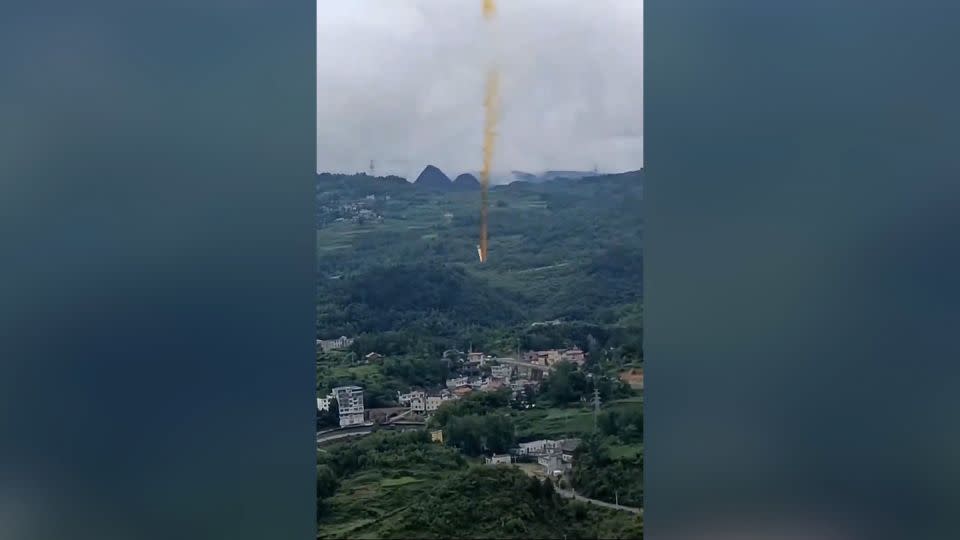Suspected debris from a Chinese missile fell to the ground over a village in southwestern China on Saturday, leaving a trail of bright yellow smoke and sending villagers fleeing, according to videos on Chinese social media and sent to CNN by a local witness.
The dramatic images surfaced online shortly after a Long March 2C launch vehicle fired at 3 p.m. local time Saturday (3 a.m. Eastern Time) from the Xichang Satellite Launch Center in southwestern Sichuan province.
The rocket sent into orbit the Space Variable Objects Monitor, a powerful satellite developed by China and France to study the farthest explosion of stars known as gamma-ray bursts.
Chinese leader Xi Jinping has vowed to establish the country as a dominant space power and step up its missions to compete with other major world powers, including the United States.
Saturday’s launch was declared a “complete success” by the China Aerospace Science and Technology Corporation (CASC), a state contractor that developed the Long March 2C rocket.
CNN has contacted the CASC and the State Council Information Office, which handles press inquiries for the Chinese government, including its space agency, for comment.
A video on Kuaishou, a Chinese short video site, appeared to show a long, cylindrical piece of debris falling over a rural village and crashing next to a hill, with yellow smoke billowing from one end.
CNN geolocated the video to be filmed from Xianqiao village in Guizhou province, bordering Sichuan province in the southeast. The video was posted to Kuaishou from an IP address in Guizhou.
Other videos circulating on Chinese social media platforms and analyzed by CNN showed multiple angles of the falling debris. In one, villagers, including children, were seen running away looking at the orange trail in the sky, while some covered their ears from the crash.
Some videos had been removed by Monday afternoon.
Witnesses on social media said they heard a loud explosion after the rubble fell into the ground. An eyewitness told CNN that they saw the rocket fall with their “own eyes.” “There was a sharp smell and the sound of an explosion,” she added.
In a now-deleted government message, which was reposted by a local villager shortly after the launch, authorities said Xinba Town, near Xianqiao village, would conduct a local “missile debris recovery mission” from 2:45 p.m. to 3:15 p.m. . time on Saturday.
Residents were asked to leave their homes and other buildings an hour before the launch and spread out into more open areas to observe the sky. They were warned to stay away from the rubble to avoid damage from “poisonous gas and explosions,” the message said.
Residents were also “strictly prohibited” from taking photos of the rubble or “distributing relevant videos online,” the notice said.
There were no reports of immediate injuries by local authorities.

‘Extremely toxic’
Markus Schiller, a rocket expert and associate principal investigator at the Stockholm International Peace Research Institute, said the debris appeared to be the first stage of the Long March 2C rocket, which uses a liquid propellant consisting of nitrogen tetroxide and asymmetric dimethylhydrazine (UDMH ).
“This combination always produces orange smoke trails. It is extremely toxic and carcinogenic,” Schiller said. “Any living thing that inhales that stuff is going to have a hard time in the near future,” he added.
Such incidents are common in China due to the location of the launch site, he said.
“If you want to launch something into low Earth orbit, you usually launch it eastward to get some extra momentum from the Earth’s rotation. But if you launch to the east, there are definitely always some villages in the path of the first phase boosters.
Most of China’s missiles are fired from its three inland launch sites: Xichang in the southwest, Jiuquan in the Gobi Desert in the northwest and Taiyuan in the north. These bases, built during the Cold War, were deliberately located far from the coast for security reasons.
In 2016, a fourth launch site, Wenchang, opened on Hainan Island, the country’s southernmost province.
By comparison, NASA and the European Space Agency typically launch their rockets from coastal locations toward the ocean, says Schiller, who is also director of ST Analytics in Munich, Germany.
Western space agencies have also largely phased out the kind of highly toxic liquid propellants for their civilian space programs that China – and Russia – still use, he added.
Multi-stage rockets shed debris shortly after explosion, along trajectories that can be predicted before launch.
Before each launch, China’s civil aviation authority typically sends a message to pilots, known as NOTAM, warning them of the “temporary danger zones” where rocket debris is likely to fall.
Debris from Chinese missiles has hit villages before. In December 2023, debris from a rocket landed in the southern province of Hunan, damaging two houses, state media reported. In 2002, a boy in northern China was injured when fragments from a satellite launch fell on his village in Shaanxi province.
“I expect we’ll see something like this for a while and for many years to come,” Schiller says.
China has previously faced criticism from the international space community over its handling of debris from its out-of-control rocket boosters as they reenter Earth.
In 2021, NASA blasted China for its failure to “meet responsible standards” after debris from its out-of-control Long March 5B rocket landed in the Indian Ocean just west of the Maldives after re-entering the atmosphere.
CNN’s Joyce Jiang, Edward Szekeres and Steven Jiang contributed reporting.
For more CNN news and newsletters, create an account at CNN.com